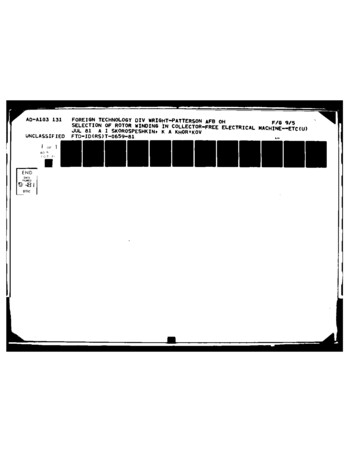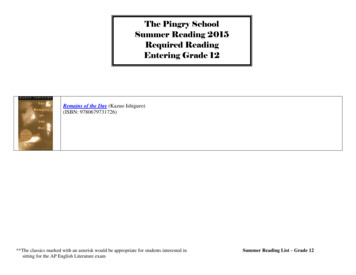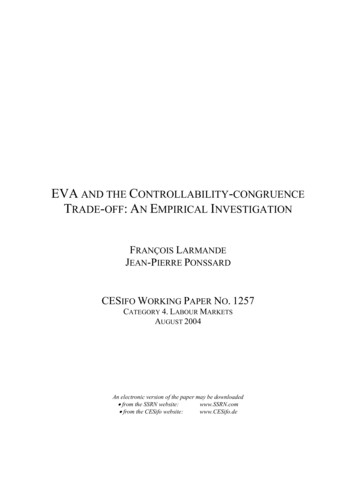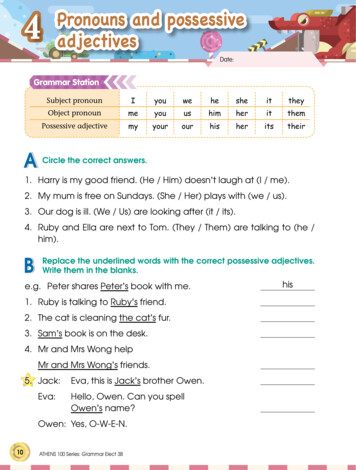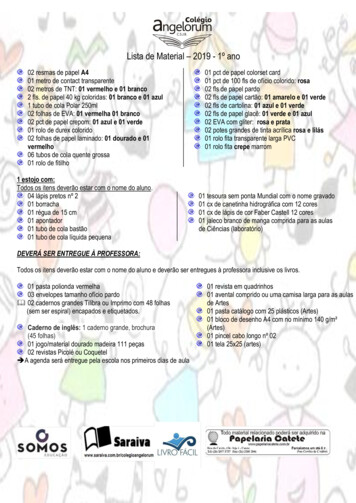
Transcription
Cent Eur J Nurs Midw 2014;5(3):117-126doi: 10.15452/CEJNM.2014.05.0006REVIEWTHE USE OF NURSING DIAGNOSES IN CLINICAL PRACTICEEva Mynaříková1, Katarína Žiaková21Division of Nursing Care, University Hospital Ostrava, Czech RepublicDepartment of Nursing, Jessenius Medical Faculty in Martin, Comenius University in Bratislava, Slovakia2Received March 25, 2014Accepted July 27, 2014AbstractAim: The aim was to determine the error rate and frequency of nursing diagnoses used in clinical practice by the means ofanalysis of available literature, and to reveal the factors influencing the accuracy and occurrence of nursing diagnoses.Methods: The following databases (1993-2013) were used as the data source for the performed analysis: PubMed, ProQuestand Google Scholar. A total of thirty-nine data sources were utilized for data processing: predictive correlational studies (9),retrospective studies using patient data (7), cross-sectional studies (4), systematic reviews (3), cohort studies (3), a randomizedtrial (1), and a longitudinal analysis (1). The data were also obtained from educational texts (7), review articles (2) and expertdisputations (2). Results: Identical problems in formulation as well as accuracy of the nursing concepts have been repeatedlyobserved during the monitoring of occurrence of the error rate in nursing diagnoses. Noted imperfections concernedidentification of determining characters, and especially related factors. Diagnoses regarding dysfunctional physical needsprevailed, whereas diagnoses in the psychosocial and spiritual areas were absent. The analysis of literature data showed thatthe factors influencing the accuracy and occurrence of nursing diagnoses in practice include the nurses and their education andexperience in nursing diagnostics, the way the nursing care is organized, technologies of the nursing documentation andinstitutional support, especially in the form of adequate staffing. Conclusion: In order to be able to provide beneficent,effective and safe care, it is necessary for managers of individual healthcare establishments to target the strategy on the systemas a whole, that is, on mutual interconnection of individual components: the people, environment, process and technologies.Key words: nursing diagnosis, accuracy, frequency, education, influencing factors, clinical practice.IntroductionStandardized terms and definitions are required inorder to ensure effective and high-quality nursingpractice. Standard nursing terminology enables toformulate nursing problems, interventions, and toassess the outcomes of nursing care. Furthermore,nursing terminology facilitates communicationamong nursing professionals and other healthcareproviders. Nursing terminology is one of the basicattributes of establishing nursing as a scientificdiscipline. Nursing is being developed viainterconnection, as well as tension among threeconstitutive elements: theory, research and nursingpractice. A part of the nursing language is beingformulated and consequently used in every one ofthese three areas. Thus the whole communityparticipates upon the formulation of the language, itsCorresponding author: Eva Mynaříková, Division of NursingCare, University Hospital Ostrava, 17. listopadu 1790, Ostrava,Czech Republic, email: eva.mynarikova@fno.cz 2014 Central European Journal of Nursing and Midwiferysubsequent codification and use of individual terms,resulting in specific expert terminology. The use ofunambiguous and well-established terminologyconstitutes the basis of classification systems innursing care. Established terminology helps nursesmake correct decisions, and at the same time enablesthem to perform research activities in clinicalsettings, with the use of the extensive database ofterms, which is being created due to the appliedterminology. The importance of established nursingterminology might be summarized in the followingpoints: Support of professional responsibility andindividuality through definition of independentactivities in nursing practice. Possibility of testing the validity of nursingdiagnoses, outcomes and interventions used inorder to achieve them.117
Mynaříková E, Žiaková K. More effective and feasible financial planning ofperformance of nursing activities. Improvingtheefficacyofmutualcommunication between nurses and otherhealthcare professionals. Use in teaching, with the impact , Holmanová, Čáp, 2008, p. 83-86).In order to precisely identify the patient problems,that is, nursing diagnoses, it is possible to use theNANDA International diagnostic system. Thissystem introduces standardized names of nursingdiagnoses, together with numerical codes anddefinitions; at the same time, the system offers anoverview of characteristic features, related or riskfactors of the diagnoses, based upon which it ispossible to confirm the occurrence of an individualnursing diagnosis in a patient, and thus make adiagnostic conclusion. A precise and documentablenursing diagnostic conclusion constitutes the basisfor decisions regarding suitable nursing interventions,which are performed in the patient by a team ofnursing professionals, in cooperation with a team ofother healthcare professionals (Marečková et al.,2013, p. 7).Even though nursing diagnoses do not present anovelty in the Czech nursing care, as their useexperienced the largest boom in the second half ofthe 1990s, it is still not possible to speak about asystematic use of them. As of today, the use ofnursing diagnostics in healthcare establishments inthe course of the nursing process may be consideredcommonplace. The Decree No. 98/2012 Coll.concerning nursing documentation determines thatthe nursing record must also contain a description ofthe nursing problem in the patient, or a nursingdiagnosis (Czech, 2012). The use of nursingdiagnostics in healthcare establishments is alsomonitored by national, as well as internationalaccreditation bodies (e.g. Joint AccreditationCommission, Joint Commission International).Nevertheless, there exists no legally bindingregulation in the Czech Republic, which woulddetermine which classification system should be usedin practice. The view upon applying the nursingdiagnostics in clinical practice varies, and everyhealthcare establishment uses its own diagnosticsummaries.Cent Eur J Nurs Midw 2014;5(3):117-126influencing the accuracy and occurrence of nursingdiagnoses in clinical practice.MethodsEligibility criteriaThe criteria for selection of sources included thesource language (Czech, Slovak and English).Various publications dealing with nursing diagnosticsand its use in clinical practice were selected.Inclusion criteria: the accuracy of nursing diagnoses(formulation, diagnostic elements), documentation ofnursing diagnoses, frequency of nursing diagnoses,factors influencing the use and accuracy of nursingdiagnoses. Exclusion criteria: validation studies ofindividual nursing diagnoses, case reports.SourcesThe following databases were searched (1993-2013):PubMed, ProQuest and Google Scholar. The data wasalso searched for in the following publications:International Journal of Nursing Terminologies andClassifications (8), Journal of Clinical Nursing (3),Journal of Advanced Nursing (2), Applied NursingResearch, The Journal of Continuing Education inNursing, International Journal of Nursing Practice,Journal of the American Medical DirectorsAssociation, Journal of Nursing Education, NursingOutlook, The Online Journal of Issues in Nursing,The Permanente Journal, Medical Care andInternational Journal of Medical Informatics. As faras Czech periodicals are concerned, the followingjournals were analyzed: Kontakt (2) andOšetřovatelství a porodní asistence (2). On fourinstances, presentations from conference abstractswere also used, and in eight cases, the informationwas obtained from other types of expert publications.SearchThe search was performed using the key wordsnursing diagnosis, accuracy, frequency, nursingdocumentation, nurses, clinical practice, education,influencing factors and environmental elements, incombination with the Boolean operators AND/OR.AimStudy selectionPredictive correlational studies (9), retrospectivestudies using patient data (7), cross-sectional studies(4), systematic reviews (3), cohort studies (3), arandomized trial (1), and a longitudinal analysis (1).The data were also obtained from educational texts(7), review articles (2) and expert disputations (2).The aim of the review study was to determine themost frequently occurring mistakes in the nursingdiagnostics, and the frequency of nursing diagnosesused in clinical practice, together with factorsData analysisA total of 65 publications were found, thirty-nine ofwhich fulfilled the inclusion criteria; this group ofstudies was included in the thematic analysis. A total 2014 Central European Journal of Nursing and Midwifery118
Mynaříková E, Žiaková K.of three topics were defined based upon the obtainedresults, depending upon the focus of the studies on:(a) accuracy of nursing diagnoses (includingcharacteristic features and related factors), (b)frequency of nursing diagnoses, and (c) factorsinfluencing the use of clinical diagnoses in clinicalpractice. The results of assorted studies based uponthe thematic focus were organized in three tables (seeTables 1-3).ResultsThe most frequent mistakes in the diagnosticsIn their study aimed at analyzing the expressions orterms used in Iceland to describe patient problems,Thoroddsen and Thorsteinsson (2002) found thatnursing diagnoses were defined according to theNANDA I terminology in only sixty percent.Doenges and Moorhouse (2003) characterized theeight most frequently occurring mistakes informulation of nursing diagnoses (Table 1). Theresults of a study performed in Sweden (Florin et al.,2005) did not reveal any issues related to formulationof the nursing problem; the nursing diagnosis wasstated precisely and exactly in most of the diagnoses.However, serious deficiencies were found in theconcept of etiology. A method similar to the one inSweden was also used in Slovakia by Žiaková,Holmanová and Čáp (2007), who in their studyidentified the occurrence of the most frequentproblems related to formulation of the diagnosticsummary. Most of the observed mistakes wereincluded in the category related to the relevance ofdocumented diagnostic signs, and in the categorypertaining to the structure of the diagnosis (Table 1).Müller-Staub et al. (2006) published a systematicreview of fourteen literary sources dealing with theeffects of nursing diagnoses upon the quality ofpatient assessment and frequency of the documentednursing diagnoses. All these fourteen peer-reviewedstudies point out deficiencies in the accuracy of thedetermined diagnoses. Some studies also refer toinsufficient knowledge of nurses in the area ofetiology. Similar conclusions were also described oneyear later (Müller-Staub et al., 2007) in a study aimedat assessing the impact of an educational program oncorrect formulation of nursing diagnoses, includingcharacteristic features and related factors, on suitableselection of nursing interventions specified for theidentified etiology, and on adequately proposedmeasurable and achievable nursing outcomesdescribing changes in the patient condition (Table 1).The frequency of nursing diagnosesThe authors Thoroddsen and Thorsteinsson (2002)analyzed nursing records of patients hospitalized at 2014 Central European Journal of Nursing and MidwiferyCent Eur J Nurs Midw 2014;5(3):117-126intensive care units, and found out that the number ofdiagnoses per one patient was between 0 and 10; in65 percent of patients, three or less diagnoses wereidentified. The number of diagnoses correlated withthe length of hospitalization but not with theincreasing age of the patients. The mean number ofnursing diagnoses per one patient was 3.28.Diagnoses pertaining to dysfunctions of bodyfunctions dominated; the frequency of diagnosedpsychosocial problems was significantly lower (Table2). Another study was performed in Japan(Ogasawara et al., 2005); its aim was to assess theuse of nursing diagnoses and interventions in femalepatients in terminal stage of breast cancer. A total of539 diagnostic conclusions were identified, a total of96 diagnoses were used in relation to this type ofdiagnosis, 47 percent of the diagnoses were usedfrom NANDA I taxonomy. Diagnoses from thepsychosocial area were used only sparsely, theauthors also revealed an absence of diagnoses aimedat the problems of care provided for dying patientsand their families (Table 2). A systematic review offourteen literary sources (Müller-Staub et al., 2006, p.519) identified a high frequency of nursingdiagnoses. Sixty percent of the records includedbetween 1 and 10 nursing diagnoses. From thesummary, it becomes apparent that the frequency ofusing nursing diagnoses varies, depending on nt (Table 2). Another study aimed at thefrequency of nursing diagnoses was performed inSlovakia by Pavelová (2005). The author performedand analysis of a relatively small sample, whencompared to other studies performed abroad, of thirtyrecords of patients hospitalized at an intensive careunit and identified the most frequent diagnoses(Table 2). Authors from Brazil, Lucena and Barros(2006), performed a survey, the aim of which was toidentify nursing diagnoses and the most frequentlylisted related or risk factors. The data was obtainedon the basis of a retrospective analysis of nursingrecords of patients hospitalized at intensive careunits. A total of sixteen most frequently occurringnursing diagnoses were defined, twelve acute andfour potential. Yet again, diagnoses from thepsychosocial and spiritual area were absent (Table 2).According to the authors, on the one hand, suchobservation could be expected, due to the fact that thecondition of patients hospitalized at intensive careunits is serious, and the imminent threat to lifedefines biological needs as a priority. However, onthe other hand, it is a well-known fact that manypatients at intensive care units encounter problemsrelated to communication, social isolation andspiritual suffering.119
Mynaříková E, Žiaková K.Cent Eur J Nurs Midw 2014;5(3):117-126Table 1 Overview of publications dealing with identifying mistakes in diagnosticsAuthors, yearDoenges,Moorhouse, 2003Identified mistakes in diagnosticsUse of medical diagnoses, complications of the disease or side effects of the treatment in formulation of the problem.Use of irreversible situations, which cannot be changed with formulation of related factors.Naming of individual symptoms of a disease with nursing diagnoses.Use of nursing interventions in formulation of a nursing problem.Lack of specificity, which does not determine the focus of nursing interventions.One nursing diagnosis includes two or more nursing problems.General determination of related factors and characteristic features, which do not specify nursing interventions and cannot beinfluenced with nursing interventions.Nursing diagnoses are defined on the basis of irrelevant or non-valid data.Diagnoses are automatically predefined within a medical diagnosis in every patient.Florin, Ehrenberg,Ehnfors, 2005Etiology not determined.The identified etiology was insufficiently precise and did not specify the focus of nursing interventions.The identified etiology could not be influenced with nursing interventions.Müller-Staub et al.,2006Imperfections in the accuracy of determined diagnoses.Imperfections in the systematic evaluation of characteristic features.Poor correlation between related factors and nursing diagnoses.Related factors were not described, or were only partially documented.Müller-Staub et al.,2007Incorrect formulation of nursing diagnostic terms.Insufficient identification of related factors and characteristic features.Improperly determined objectives of the nursing care.Thoroddsen,Thorsteinsson,2002Nursing interventions, medical diagnoses or risk of complications related to a medical procedure or treatment were listed asnursing problems.Diagnostic conclusions did not correspond with the formulation of nursing diagnoses in NANDA I.One nursing diagnosis included two or more nursing problems.Automatic allocation of diagnoses to patients in perioperative care.Diagnostic terms were not supported with relevant data, using evaluation scales.The identified etiology was not sufficiently specific and did not specify the focus of nursing interventions.The identified etiology could not be influenced with nursing interventions.Žiaková,Holmanová, Čáp,2007In the Czech Republic, Marečková and Tománková(2007) identified the most frequent nursing diagnosesin patients with an impairment of consciousness. Theauthors proposed a group of 32 nursing diagnoses; afrequency of at least 10 percent was observed in 29nursing diagnoses from the proposed file. In case of15 diagnoses, the frequency reached 100 percent(Table 2). Marečková and Tomanová concluded theirstudy with a recommendation to create speciallydesigned groups of probands for the purpose ofresearch analysis related to nursing diagnostics,according to the types of illness or time factor, that is,inclusion of probands in individual stages ofcontinuous care. In 2010, Thoroddsen, Ehnfors andEhrenberg performed a study examining the use ofstandardized nursing terminology in nursing recordsin four selected specialties (surgery, internalmedicine, geriatrics and psychiatry). They were ableto allocate a total of 1261 nursing conclusions, whena total of 63 diagnoses were used in relation of thetype of diagnosis within all four specialties. Theperformed study revealed an extensive use andvariability in the area of nursing diagnoses in thesefour nursing specialties. The most frequently 2014 Central European Journal of Nursing and Midwiferyobserved nursing diagnoses across all specialtiesrepresent the basic human needs of the patients(Table 2). From the group of nine nursing diagnoseswhich were common for all clinical specialties, eightrepresented the basic needs of patients, includingsleep, nutrition, elimination, self-care, and problemswith the skin, emotions and reasoning. The frequencyof nursing diagnoses in patients in home care in theCzech Republic was assessed within a project whichattempted to bridge the gap between the currenttheoretical knowledge and the outcomes of researchand the nursing practice in the area of nursingdiagnostics, planning and documentation of nursingcare. One of the four aims of the project was to createa basic file of NANDA I nursing diagnoses suitablefor specific groups of clients in home care (Table 2).The project confirmed a good usability of thesystematic international terminology NANDA I andNIC in nursing practice. The results of the study alsoshowed that the use of universal nursing terminology,especially NIC, could be beneficial for descriptionand records of the work of nurses (Jarošová, 2012, p.94).120
Mynaříková E, Žiaková K.Cent Eur J Nurs Midw 2014;5(3):117-126Table 2 Overview of publications dealing with the frequency of nursing diagnosesJarošová et al., 2012Observedworkplaces/patientsHomecareLucena, Barros, 2006Intensive care unitMarečková, Tománková,2007Patients with impairedconsciousnessMüller-Staub et al., 2006Patients with leukemiaIneffective coping, Disrupted thought processes, Self-care deficit.Ogasawara et al., 2005Establishments of acutepsychiatric carePatients in terminal stageof breast cancerIntensive care unitsIntensive care unitsSelf-care deficit, Impaired mobility, Disrupted skin and tissue integrity, Hyperthermia.SurgeryRisk of surgical complications, Non-effective patency of breathing passageways, Impairedgastrointestinal function, Preparation for discharge, Self-care deficit, Pain, Impairedmobility, Constipation, Disrupted sleep, Disrupted thought processes, Insufficientnutrition, Disrupted skin integrity, Risk of disrupted skin integrity, Disrupted tissueintegrity, Risk of disrupted tissue integrity.Non-effective breathing, Insufficient nutrition and Insufficient tissue perfusion.Preparation for discharge, Self-care deficit, Pain, Impaired mobility, Constipation,Disrupted sleep, Disrupted thought processes, Insufficient nutrition, Disrupted skinintegrity, Risk of disrupted skin integrity, Disrupted tissue integrity, Risk of disruptedtissue integrity.Chronic confusion, Constipation, Risk of falls, Preparation for discharge, Self-care deficit,Pain, Impaired mobility, Disrupted sleep, Disturbed thought processes, Insufficientnutrition, Disrupted skin integrity. Risk of disrupted skin integrity, Disrupted tissueintegrity, Risk of disrupted tissue integrity.Disrupted sleep, Impaired social interaction, Preparation for discharge, Self-care deficit,Constipation, Disrupted sleep, Disrupted thought processes, Insufficient nutrition,Disrupted skin integrity. Risk of disrupted skin integrity, Disrupted tissue integrity, Riskof disrupted tissue integrity.Authors, yearPavelová, 2005Thoroddsen, Thorsteinsson,2002Thoroddsen, Ehnfors,Ehrenberg, 2010Internal medicineGeriatricsPsychiatryNursing diagnosesRisk of falls (00155), Impaired mobility (00085), Risk of infection (00004), Chronic pain(00133), Risk for deficient fluid volume (00028), Dressing or grooming self-care deficit(00109), Bathing or hygiene self-care deficit (00108), Disturbed thought processes(00130), Risk of disrupted skin integrity (00047).Bathing or hygiene self-care deficit, Risk of infection, Impaired mobility, Ineffectivebreathing, Impaired spontaneous ventilation, Risk of disrupted skin integrity.Risk of falls (00155), Impaired mobility (00085), Risk of infection (00004), Chronic pain(00133), Risk for deficient fluid volume (00028), Dressing or grooming self-care deficit(00109), Bathing or hygiene self-care deficit (00108), Disturbed thought processes(00130), Risk of disrupted skin integrity (00047).Lack of sleep, Disrupted skin integrity, Pain, Imbalanced nutrition, Nausea, Self-caredeficit.Chronic pain, Risk of infection, Risk of injury, Intolerance of activity, Changed nutrition,Anxiety.Acute pain, Fear, Risk of infection.Factors influencing the use of nursing diagnoses inclinical practiceThe analysis of literary sources dealing with nursingdiagnostics revealed four basic factors whichsignificantly influence the quality of nursingdiagnostics: the nurse, education in the area ofdiagnostics, condition of the patient, institutionalsupport and organization factors.The nurseThe authors Carnevali and Thomas (1993) andGordon (1994) consider the nurse as a significantfactor influencing the accuracy of diagnostics.Furthermore, Brannon and Carson (2003) consideralso education in clinical diagnostics, diagnosticexperience and skills of the nurse in intellectual,interpersonal and technical areas to be influencingfactors in the process of clinical decision-making.Also other authors put emphasis on the necessity ofinterpersonal communication skills of nurses(Lunney, 2008; Munhall, 1993; Tanner, 2006; 2014 Central European Journal of Nursing and MidwiferyMcCabe, 2004). According to Lunney (2010), it isimportant for the nurse, in order to be a gooddiagnostician, to master three types of competences,namely intellectual, interpersonal and technicalcompetences. An important aspect encompassingintellectual competence is the ability of critical andsometimes also clinical reasoning, which is necessaryin order to obtain exact patient data and a suitablechoice of interventions. Paans et al. (2011) confirmedthat the accuracy of nursing diagnoses positivelyinfluenced the ability of nurses to use criticalreasoning and the degree of experiences andknowledge concerning diagnostics. Also Žiaková etal. (2013) stated that the attitude to substantiating anursing diagnosis and nurses’ critical reasoning mayinfluence the way in which they document theirdiagnostic conclusions (Table 3).Education in the area of diagnosticsThe beneficial impact of educational sessions aimedat the nursing process has been confirmed by a study121
Mynaříková E, Žiaková K.monitoring the effect of an educational program forregistered nurses, which was aimed at improvingknowledge in the nursing process (Florin et al.,2005). The results of analysis of fourteen studiesperformed by Müller-Staub et al. (2006) show thatthe use of educational programs aimed at nursingdiagnostics significantly influences the quality offormulation of nursing diagnoses and management ofnursing documentation. Another study wasperformed in 2007, with the aim to assess the impactof an educational program upon the correctness ofnursing diagnoses, including characteristic featuresand related factors. Following the implementation ofthe planned educational program, the authorsobserved a significant improvement in the quality ofthe documented nursing diagnoses, interventions andoutcomes (Müller-Staub et al., 2007). The need foreducational programs in the area of nursingdiagnostics has been also confirmed by Cruz et al.(2009). Carpenito-Moyet (2010) pointed to the factthat although the curriculum of nursing educationincludes education regarding the nursing process andnursing diagnoses, a transfer of these basic elementsinto practice is missing. Pospíšilová et al. (2012)recommended that greater attention is paid to theprocess of teaching the nursing diagnostics, includingthe NIC and NOC classification systems, at all levelsof the educational process. With this proclamation,the authors also emphasized the fact, thatpostgraduate specialization education in the CzechRepublic is aimed more at improving knowledge inthe individual specialized areas, rather thanimproving knowledge in the area of nursing as awhole. Dolák, Scholz and Tóthová (2012) in theirobservations claim that nurses do not have a positiveattitude to the use of standardized nursingclassification systems; the greatest tendency toneglect the use of the system of nursing diagnosesmay be observed in nurses with the longestexperience in practice, and nurses with secondarynursing education. The authors see the starting pointin order to ensure a systematic use of nursingdiagnoses mainly in implementation of educationalprograms aimed at the issues of nursing diagnosticsin individual healthcare establishments. In relation toeducation, Žiaková et al. (2013) referred to the lackof high-quality expert publications available in thenational languages; the authors also stress the factthat nursing, as a scientific discipline, experiences agreat development of knowledge, which, however, isonly minimally applied in practice (Table 3).Condition of the patientAnother fact influencing the nursing diagnostics isthe severity of the patient’s condition. Paans et al. 2014 Central European Journal of Nursing and MidwiferyCent Eur J Nurs Midw 2014;5(3):117-126(2011, p. 2391), authors of a systematic review,identified three factors: cultural diversity inexpressing the patient’s needs, seriousness of themedical diagnose in specialized areas, and the meansof expressing serious diagnoses. Also according toOgasawara et al. (2005), the absence of nursingdiagnoses associated with dying and death is relatedto socio-cultural influences, which affect the attitudesand behavior of nurses towards terminally ill patients.Many patients and their families may havedifficulties expressing their feelings towardshealthcare professionals. The unwillingness ofpatients to speak about certain problems has beenidentified as a barrier, which influences the use of thenursing diagnostics; this fact represents a finding of astudy aimed at identifying the stimuli and barriers inthe use of nursing diagnoses (Žiaková et al., 2013).Institutional support and organization factorsA very commonly mentioned factor influencing theaccuracy of nursing diagnostics is the administrativeload on nurses. Hedberg and Larsson (2004), Paganinet al. (2008), Paans et al. (2011) or Macková andZeleníková (2012) refer to the observation that nursesare required, apart from other activities, to performalso technical and administrative duties, and thushave less time for the nursing process. Similarconclusions were drawn also in other studies,determining how the nurses spend their workingtime, which showed that approximately half of thenurses’ time is consumed by performing indirectinterventions (work with patient records, etc.), andonly one third of the time is spent on directinterventions (Bulechek et al., 2006; Hendrich et al.,2008; Munyisia, 2011) (Table 3).Also Cheevakasemsook et al. (2006) dealt withobstacles related to nursing documentation. In theirstudy, the authors determined three areas related tothe complexities of nursing documentation; thesewere the disruption, inappropriate charting andincompleteness. The authors recommend to perform arevision and modification of the nursingdocumentation, based upon the requirements arisingfrom practice, and also to educate nurses in this area.Many authors also refer to the fact that the method,which may significantly relieve the administrativeload placed on nurses, is the implementation ofelectronic medical records. Another advantage of theelectronic patient record is the possibility to ensureexact and measureable information and statisticaldata for evidence of the nursing care, planning ofcosts related to nursing care and research data (Jerantet al., 2001; Lavin et al., 2004; Levin, McEwan,2001; Brokel, Heath, 2010, Jarošová, 2012) (Table3).122
Mynaříková E, Žiaková K.Cent Eur J Nurs Midw 2014;5(3):117-126Table 3 Overview of publications dealing with factors influencing the use of nursing diagnosesAuthors, yearBostick et al., 2006Brannon, Carson, 2003Brokel, Heath, 2010Bulechek, Butcher, Dochterman 2008Carnevali, Thomas, 1993Carpenito-Moyet, 2010Cruz, Pimenta, Lunney, 2009Červinková, Marečková, 2007Dolák, Scholz, Tóthová, 2012Florin, Ehrenberg, Ehnfors, 2005Gordon, 1994Hedberg, Larsson, 2004Hendrich, 2008Cheevakasemsook, 2006Jarošová, 2012Je
Standard nursing terminology enables to formulate nursing problems, interventions, and to . system introduces standardized names of nursing diagnoses, together with numerical codes and definitions; at the same time, the system offers an . International Journal of Medical Informatics. As far as Czech periodicals are concerned, the following .



